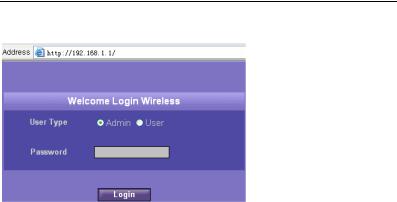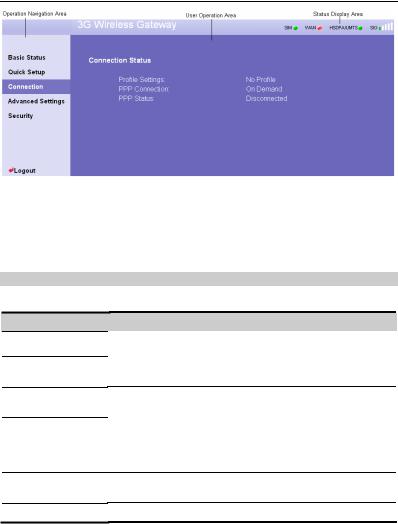Huawei E960 User Manual
Wonderful Communication, Mobile Life.
Welcome to HUAWEI E960 Wireless Gateway.
HUAWEI E960 Wireless Gateway
User Guide

Copyright © 2007 Huawei Technologies Co., Ltd.
All Rights Reserved
No part of this manual may be reproduced or transmitted in any form or by any means without prior written consent of Huawei Technologies Co., Ltd.
Trademarks
 and HUAWEI are trademarks of Huawei Technologies Co., Ltd. All other trademarks and trade names mentioned in this manual are the property of their respective holders.
and HUAWEI are trademarks of Huawei Technologies Co., Ltd. All other trademarks and trade names mentioned in this manual are the property of their respective holders.
Notice
The information in this manual is subject to change without notice. Every effort has been made in the preparation of this manual to ensure accuracy of the contents, but all statements, information, and recommendations in this manual do not constitute the warranty of any kind, expressed or implied.

Safety Precautions
Read the safety precautions carefully to ensure the correct and safe use of your wireless device. For detailed information, see Chapter 15 "Warnings and Precautions."
Do not switch on your device when the device use is prohibited or when the device use may cause interference or danger.
Do not use your device while driving.
Follow the rules or regulations in hospitals and health care facilities. Switch off your device near medical apparatus.
Switch off your device in an aircraft. The device may cause interference to control signals of the aircraft.
Switch off your device near high-precision electronic devices. The device may affect the performance of these devices.
Do not attempt to disassemble your device or its accessories. Only qualified personnel are allowed to service or repair the device.
Do not place your device or its accessories in containers with strong electromagnetic field.
Do not place magnetic storage media near your device. Radiation from the device may erase the information stored on them.
Do not put your device in a high-temperature place or use it in a place with flammable gas such as a gas station.
Keep your device and its accessories away from children. Do not allow children to use your device without guidance.
Use approved batteries and chargers only to avoid explosion.
Observe the laws or regulations on device use. Respect others’ privacy and legal rights when using your device.

|
Table of Contents |
|
1 |
Getting to Know Your E960.................................................................................................. |
1 |
|
Appearance .................................................................................................................... |
1 |
|
PC Configuration Requirements ................................................................................... |
2 |
2 |
Using the E960 Configuration Page ..................................................................................... |
3 |
|
Logging in to the Management Page............................................................................. |
3 |
|
Describing the Management Page................................................................................. |
4 |
|
Using the Quick Setup Wizard ...................................................................................... |
5 |
|
Connecting to the Internet ............................................................................................. |
5 |
|
Validating the PIN Code................................................................................................ |
6 |
|
Viewing the Gateway Configuration Information......................................................... |
6 |
3 |
Quickly Configuring the Gateway........................................................................................ |
7 |
|
Configuring PPP Profile Settings .................................................................................. |
7 |
|
Selecting the PPP Connection Mode............................................................................. |
7 |
|
Configuring the WLAN Setting .................................................................................... |
7 |
|
Configuring the WLAN Encryption Mode ................................................................... |
8 |
|
Validating Quick Setup.................................................................................................. |
9 |
4 |
Configuring Your Computer ............................................................................................... |
10 |
|
Wireless Configuration................................................................................................ |
10 |
|
Configuring the PC Network....................................................................................... |
11 |
5 |
Describing Advanced Settings ............................................................................................ |
14 |
6 |
Managing the System.......................................................................................................... |
16 |
|
Modifying the Password.............................................................................................. |
16 |
|
Upgrading the Gateway............................................................................................... |
16 |
|
Restoring Factory Defaults.......................................................................................... |
17 |
|
Restarting the Device .................................................................................................. |
17 |
|
Viewing the Version Information ................................................................................ |
17 |
7 |
Configuring SIM Card Settings .......................................................................................... |
18 |
|
Enabling or Disabling the PIN Code........................................................................... |
18 |
|
Unlocking the PIN Code ............................................................................................. |
18 |
|
Modifying the PIN Code ............................................................................................. |
19 |
|
|
i |

8 Configuring UMTS Settings ............................................................................................... |
20 |
Choose the Preferred Mode and Band......................................................................... |
20 |
Configuring the Mode for Searching Network ........................................................... |
21 |
9 Configuring Dial-up Settings.............................................................................................. |
22 |
Configuring PPP Settings ............................................................................................ |
22 |
Managing the Profile List............................................................................................ |
23 |
10 Assigning IP Addresses ..................................................................................................... |
25 |
11 Configuring the WLAN .................................................................................................... |
26 |
Enabling or Disabling the WLAN............................................................................... |
26 |
Configuring WLAN Settings....................................................................................... |
26 |
Advanced WLAN Settings .......................................................................................... |
27 |
Configuring the MAC Filter........................................................................................ |
29 |
12 Security Settings................................................................................................................ |
30 |
Firewall Switch............................................................................................................ |
30 |
LAN MAC Filter ......................................................................................................... |
31 |
LAN IP Filter............................................................................................................... |
31 |
Virtual Server............................................................................................................... |
32 |
Special Applications.................................................................................................... |
33 |
DMZ Service ............................................................................................................... |
34 |
UPnP Setting................................................................................................................ |
35 |
Remote Web Management........................................................................................... |
35 |
13 Typical Networking Example ........................................................................................... |
36 |
14 Troubleshooting................................................................................................................. |
37 |
15 Warnings and Precautions ................................................................................................. |
41 |
16 Abbreviations .................................................................................................................... |
44 |
ii

1 Getting to Know Your E960
Your E960 supports HSDPA/WCDMA 2100, GSM/GPRS/EDGE 1900/1800/900/850, and network auto-switch. With the E960, you can experience wireless gateway and USB modem at any time and any place.
Appearance
1.Phone cable interface
2.Ethernet cable interface
3. |
Power adapter/USB cable |
|
|
|
interface |
9 |
1 |
4. |
Pedestal |
8 |
|
5. |
Network mode indicator |
|
|
7 |
|
||
6. |
Signal strength indicator |
2 |
|
7. |
ON/OFF key |
6 |
|
8. |
WLAN indicator |
5 |
|
9. |
Power indicator |
|
|
|
|
|
3 |
|
|
|
4 |
Indicator and Button
The following table introduces the indicator and button of your E960.
|
Indicator |
Power |
When it is steady on in yellow, the E960 is switched on successfully. |
|
|
WLAN |
If it is steady on and in yellow, the WLAN is enabled. If it is |
|
blinking, data is transmitting |
|
|
1

Signal strength
Network mode
ON/ OFF
Indicator
yFast blinking in red: SIM card faults (SIM card does not exist or the PIN code is not verified)
ySteady on and in red: signal strength in level one (weak)
ySteady on and in yellow: signal strength in level two or three (middle)
ySteady on and in green: signal strength in level four or five (strong)
yDouble blinking in green: searching the network
yBlinking in green: registering with the 2G network
ySteady on and in green: GPRS/EDGE data service connected
yFast blinking in green: Downloading the upgrade mode
yBlinking in blue: registering with the 3G network
ySteady on and in blue: WCDMA data service connected
ySteady on and in cyan: HSDPA data service connected
Note: When the gateway is initialized, it is steady on and in green for three seconds.
Button
Press and hold it to power on or off the E960
Interfaces
yPower adapter/USB cable interface: When connected with the power adapter, the E960 functions as a wireless gateway. When connected to the PC with a USB data cable, the E960 functions as a USB modem.
yEthernet cable interface: Insert an Ethernet cable connected to the PC or other network equipments.
yPhone cable interface: Insert a phone cable connected with a telephone to realize the voice service.
PC Configuration Requirements
The recommended PC configurations for using the E960 are as follows:
yCPU: Pentium 500 MHz or above
yMemory: 128 MB RAM or above
yHard disk: 100 MB available space
yLCD resolution: 800*600 pixel or above, recommended 1024*768 pixel
yInterface: standard USB interface
yOperating System: Windows 2000, Windows XP, or Windows Vista
yInternet Browser: Internet Explorer 6.0 or above, Firefox 1.5 or above, Netscape 8.0 or above
2

2 Using the E960 Configuration
Page
Logging in to the Management Page
1.Start the IE browser, and then enter the address http://192.168.1.1 in the address bar.
2.Select User Type, enter Password, and then click  .
.
yAdmin: Has the rights to view and modify the configurations. The default password is admin;
yUser: Has the right to view only the basic information. The default password is user.
Note:
To avoid the configuration conflict, only one user can log in to the E960 management page at a time.
3

Describing the Management Page
yOperation Navigation Area: Shows the main functions of the management console.
yUser Operation Area: Shows configuration information, data information, help information, and function operation area of the gateway. The user operation window varies with different function operations.
yStatus Display Area: Shows the network mode, PPP dial-up status, network signal strength, and SIM card status in real-time.
Operation Functions
The following table shows the main operations in the gateway management page.
Item
Basic Status
Quick Setup
Connection
Advanced Settings
Security
Logout
Description
Displays the parameter configuration status of the gateway. For details, see "Viewing the Gateway Configuration Information."
Configures the gateway quickly. For details, see Chapter 4 "Quickly Configuring the Gateway."
Displays the network connection status and connects to the network. For details, see "Connecting to the Internet."
Configures the advanced settings of the gateway, which includes the following settings: system, SIM card, UMTS, dial-up, DHCP, and WLAN. For details, see Chapter 6 "Describing Advanced Settings."
Configures the Security settings of the gateway, For details, see “Security Settings”.
Log out of the gateway page
4

Gateway Status
The following table shows the gateway status information.
Item |
Description |
SIM |
The SIM card is valid. |
|
 The SIM card is not inserted or invalid.
The SIM card is not inserted or invalid.
WAN |
The PPP dial-up connection |
The PPP dial-up connection |
|
is successful. |
is failed. |
|
|
|
WCDMA |
The WCDMA network is |
The WCDMA network is |
|
||
|
connected. |
unavailable. |
|
Note: |
|
|
If the gateway is registered with other network modes, the |
|
|
corresponding network connection status is displayed. |
|
|
|
|
SIG |
The signal strength from weak to strong is shown as follows: |
|
|
|
|
Using the Quick Setup Wizard
The quick setup wizard guides you to configure the most important settings of the gateway.
If you are using the gateway configuration page for the first time, the system displays the quick setup wizard page by default after you log in. You can configure the basic parameters quickly by following the prompts. For details, refer to Chapter 4 "Quickly Configuring the Gateway."
Connecting to the Internet
Accessing the Connection Status Page
yClick Connection to access the page.
yAfter you log in to the management page again, you can automatically access the connection status page.
Connecting to the Internet
1.If the PIN code protection is enabled, the system prompts you to validate the PIN code. For details, see "Validating the PIN Code."
2.If PPP Connection is Auto or Demand, refresh the page to view the current network connection status.
3.If PPP Connection is Manual, click or
or  to connect or disconnect from the network.
to connect or disconnect from the network.
5

4.Wait for several minutes, if you are prompted that the connection is successful, you can start the IE browser and enter the website address to access the Internet.
Validating the PIN Code
If the PIN code protection is enabled, you are prompted to validate the PIN code when you restart the gateway and log in to the management page.
1.Enter the correct PIN code, and then click .
.
Note:
yFor the initial PIN code, consult your service provider.
yIf you enter wrong PIN codes for three successive times, the PIN is locked. For details, see "Unlocking the PIN Code."
yIf the PIN validation fails, you cannot use the network-related functions.
2.When you succeed in validating the PIN code, click  to access the network connection page.
to access the network connection page.
Viewing the Gateway Configuration Information
On the gateway configuration page, you can view the current parameter configuration information of the gateway and the network connection status. The network connection status includes WAN, LAN, and WLAN.
1.Click Basic Status in the operation navigation area.
2.Click  on the right part of the page to view the status of the gateway.
on the right part of the page to view the status of the gateway.
3.Click  to view the current status of the gateway on the advanced status page.
to view the current status of the gateway on the advanced status page.
6

3 Quickly Configuring the Gateway
You can use the quick setup wizard to configure and maintain the basic parameters of the gateway. Click Quick Setup in the operation navigation to access the welcome page. Click
 to access the PPP profile setting page following the page prompts.
to access the PPP profile setting page following the page prompts.
Configuring PPP Profile Settings
yProfile Name: Enter the profile name when the text box is null.
yDial-up Number/PPP User Name/PPP Password: Enter these three parameters provided by the internet service provider (ISP). The dial-up number is used to initiate the network call; and the PPP user name and password is used to gain the service authorization provided by the ISP.
yAPN/IP Address: Select the mode for obtaining the APN or IP address. If the carrier provides the relevant parameters, select Static and enter the APN and IP address. Otherwise, you need to select Dynamic and the gateway automatically obtains them.
Selecting the PPP Connection Mode
PPP Connection: It is used to select the dial-up access mode.
yAuto: After the gateway is switched on, it automatically connects to the Internet and will not disconnect regardless of the data transmission.
yOn Demand: The gateway automatically connects to the Internet when there is data transmission. It automatically closes the connection when there is no data transmission.
yManual: Manual dial-up. For details, see "Connecting to the Internet."
PPP Authentication: The service is provided by your Internet Service Provider (ISP). For details, consult your ISP.
Configuring the WLAN Setting
SSID: Enter a name for your WLAN.
The service set identifier (SSID) is used to identify a WLAN. A wireless terminal (such as a PC) and the wireless gateway can perform normal data communication only when they have the same SSIDs. To ensure the WLAN security, do not use the default SSID. You can enter a character string as the SSID, such as MyHome.
7

SSID Broadcast: Enable or disable the SSID broadcast.
yEnabled: The E960 broadcasts the SSID of the WLAN, and users can easily access the WLAN. Unauthorized users, however, can also easily access the WLAN because the SSID is broadcasted.
yDisabled: The E960 does not broadcast the SSID of the WLAN. Before accessing the WLAN, the user must obtain the SSID of the WLAN. Thus, the WLAN security is improved.
Note:
For the convenience of the client accessing the WLAN, you can select Enabled for SSID Broadcast when you configure the WLAN setting. Once you finish setting up the WLAN, you can disable the SSID broadcast to improve the security of the WLAN.
Configuring the WLAN Encryption Mode
To access the wireless network, you must set the wireless security key of your PC be consistent with that of the wireless gateway.
No Encryption
For the convenience of the client accessing the WLAN, you can set the Encryption mode to NO ENCRYPTION when you set up a WLAN. In daily use, however, this option is not recommended for the security of the WLAN.
WPA-PSK/WPA2-PSK
yWPA-PSK is a 256-bit data encryption method that can automatically change the key.
yWPA2-PSK is a more secure version of WPA-PSK, and it supports the IEEE 802.11 standard.
yWPA Encryption is algorithms for selecting the WPA data encryption. There are three algorithms: TKIP, AES, and TKIP+AES.
yWPA Pre-Shared Key: You can enter 64-character hexadecimal value or 8–63-character ASCII value as the key. The ASCII value contains all characters that can be entered through the PC keyboard, and the hexadecimal value contains numbers of 0–9 and characters of A–F. For example, you can enter the ASCII value of 1234abcde as the key.
yNetwork Key Rotation Interval: It is used to set how long a network key is dynamically changed. By default, it is 0. To disable this function, you can set the value to
0 or Null.
WEP
Wireless Equivalent Privacy, a 64-bit or 128-bit data encryption method. The 128-bit WEP encryption provides higher security level.
Network key 1: You can enter 5 ASCII characters or 10-character hexadecimal numeral to form a 64-bit key. You can also enter 13 ASCII characters or 26-character hexadecimal numeral to form a 128-bit key.
8

Validating Quick Setup
The last page of the wizard displays the all settings you have configured.
yTo accept settings, click  to submit the information.
to submit the information.
yTo make changes, click  to return.
to return.
yClick  to quit the settings.
to quit the settings.
9

4 Configuring Your Computer
In this part, take the Window XP operating system (OS) as an example to describe how to configure your computer. For other OSs, the configuration may be different; thus, you need to configure it according to the actual situation.
Wireless Configuration
The wireless configuration enables your PC connect to the E960 through the wireless network. If you need only the Ethernet to connect your PC, you do not need to configure this.
Configuration Requirements
yTo set up wireless network connection, your PC must have been configured with the WLAN adapter that supports the IEEE 802.11 b/g protocol.
yIf the encryption function is enabled, you need to ensure that all PCs connecting to the E960 use the same key with the E960.
yFor the use of WLAN adapter, refer to the WLAN adapter user guide provided by the manufacturer.
ySee "Configuring the WLAN Encryption Mode" for the encryption configuration.
ySee "Configuring the WLAN Setting" for SSID parameters configuration.
Configuring the Wireless Network Connection
1.Select Start > Control Panel > Network Connections > Wireless Network Connection.
2.Click Show Wireless Networks to display the wireless network connection list.
3.Select the network connection that the SSID is consistent with that in the E960 WEB configuration, and then click .
.
10

4.If the encryption parameter is set for the E960, the Wireless Network Connection dialog box is displayed and requires the network key and confirmation. The value you entered must be consistent with the WPA Pre-Shared Key or Network Key of the E960.
5.Wait for several minutes after you enter the correct network key. The wireless connection icon displays in the status area in the lower right corner of the screen. Then, your PC can automatically connect to the E960.
Configuring the PC Network
The recommended configurations of the gateway are as follows:
yObtain an IP address automatically.
yDeselect Use a proxy server for your LAN.
11
